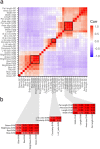Analyzing Medicago spp. seed morphology using GWAS and machine learning
- PMID: 39080407
- PMCID: PMC11289399
- DOI: 10.1038/s41598-024-67790-4
Analyzing Medicago spp. seed morphology using GWAS and machine learning
Abstract
Alfalfa is widely recognized as an important forage crop. To understand the morphological characteristics and genetic basis of seed morphology in alfalfa, we screened 318 Medicago spp., including 244 Medicago sativa subsp. sativa (alfalfa) and 23 other Medicago spp., for seed area size, length, width, length-to-width ratio, perimeter, circularity, the distance between the intersection of length & width (IS) and center of gravity (CG), and seed darkness & red-green-blue (RGB) intensities. The results revealed phenotypic diversity and correlations among the tested accessions. Based on the phenotypic data of M. sativa subsp. sativa, a genome-wide association study (GWAS) was conducted using single nucleotide polymorphisms (SNPs) called against the Medicago truncatula genome. Genes in proximity to associated markers were detected, including CPR1, MON1, a PPR protein, and Wun1(threshold of 1E-04). Machine learning models were utilized to validate GWAS, and identify additional marker-trait associations for potentially complex traits. Marker S7_33375673, upstream of Wun1, was the most important predictor variable for red color intensity and highly important for brightness. Fifty-two markers were identified in coding regions. Along with strong correlations observed between seed morphology traits, these genes will facilitate the process of understanding the genetic basis of seed morphology in Medicago spp.
Keywords: Medicago sativa; Alfalfa; Area size; GWAS; Machine learning; RGB; Seed color; Seed morphology.
© 2024. This is a U.S. Government work and not under copyright protection in the US; foreign copyright protection may apply.
Conflict of interest statement
The authors declare no competing interests.
Figures







Similar articles
-
Integrative analysis of seed morphology, geographic origin, and genetic structure in Medicago with implications for breeding and conservation.BMC Plant Biol. 2025 Mar 3;25(1):274. doi: 10.1186/s12870-025-06304-4. BMC Plant Biol. 2025. PMID: 40025430 Free PMC article.
-
Genome-Wide Association Mapping and Genomic Selection for Alfalfa (Medicago sativa) Forage Quality Traits.PLoS One. 2017 Jan 9;12(1):e0169234. doi: 10.1371/journal.pone.0169234. eCollection 2017. PLoS One. 2017. PMID: 28068350 Free PMC article.
-
Genome-wide association study identified candidate genes for seed size and seed composition improvement in M. truncatula.Sci Rep. 2021 Feb 19;11(1):4224. doi: 10.1038/s41598-021-83581-7. Sci Rep. 2021. PMID: 33608604 Free PMC article.
-
Strategies to Increase Prediction Accuracy in Genomic Selection of Complex Traits in Alfalfa (Medicago sativa L.).Cells. 2021 Nov 30;10(12):3372. doi: 10.3390/cells10123372. Cells. 2021. PMID: 34943880 Free PMC article. Review.
-
Functional Genomics and Seed Development in Medicago truncatula: An Overview.Methods Mol Biol. 2018;1822:175-195. doi: 10.1007/978-1-4939-8633-0_13. Methods Mol Biol. 2018. PMID: 30043305 Review.
Cited by
-
Integrative analysis of seed morphology, geographic origin, and genetic structure in Medicago with implications for breeding and conservation.BMC Plant Biol. 2025 Mar 3;25(1):274. doi: 10.1186/s12870-025-06304-4. BMC Plant Biol. 2025. PMID: 40025430 Free PMC article.
References
-
- Chastain, T. G., Ward, K. J. & Wysocki, D. J. Stand establishment response of soft white winter wheat to seedbed residue and seed size. Crop Sci.35, 213–218 (1995).10.2135/cropsci1995.0011183X003500010040x - DOI
-
- United States Department of Agriculture. USDAhttps://www.nass.usda.gov/Statistics_by_Subject/result.php?32C485CC-791F... (2022).
-
- Veronesi, F., Brummer, E. C. & Huyghe, C. Alfalfa. In Fodder Crops and Amenity Grasses (eds Boller, B. et al.) 395–437 (Springer, 2010).
-
- Teuber, L. R. & Brick, M. A. Morphology and Anatomy. In Alfalfa and Alfalfa Improvement (eds Hanson, A. A. et al.) 125–162 (American Society of Agronomy, 1988).
MeSH terms
LinkOut - more resources
Full Text Sources
Miscellaneous

